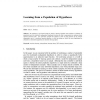Free Online Productivity Tools
i2Speak
i2Symbol
i2OCR
iTex2Img
iWeb2Print
iWeb2Shot
i2Type
iPdf2Split
iPdf2Merge
i2Bopomofo
i2Arabic
i2Style
i2Image
i2PDF
iLatex2Rtf
Sci2ools
92
Voted
COLT
1993
Springer
1993
Springer
Learning from a Population of Hypotheses
We introduce a new formal model in which a learning algorithm must combine a collection of potentially poor but statistically independent hypothesis functions in order to approximate an unknown target function arbitrarily well. Our motivation includes the question of how to make optimal use of multiple independent runs of a mediocre learning algorithm, as well as settings in which the many hypotheses are obtained by a distributed population of identical learning agents.
COLT 1993 | Independent Hypothesis Functions | Learning Algorithm | Machine Learning | Mediocre Learning Algorithm |
Related Content
| Added | 09 Aug 2010 |
| Updated | 09 Aug 2010 |
| Type | Conference |
| Year | 1993 |
| Where | COLT |
| Authors | Michael J. Kearns, H. Sebastian Seung |
Comments (0)

